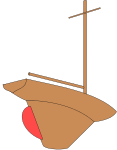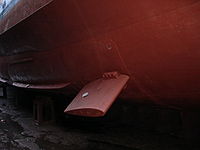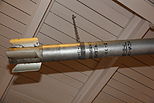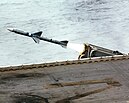Fin

A fin is a thin component or appendage attached to a larger body or structure.
Fins first evolved on
The fins on the tails of cetaceans,
Thrust generation
Foil shaped fins generate
Cavitation can be a problem with high power applications, resulting in damage to propellers or turbines, as well as noise and loss of power.[8] Cavitation occurs when negative pressure causes bubbles (cavities) to form in a liquid, which then promptly and violently collapse. It can cause significant damage and wear.[8] Cavitation damage can also occur to the tail fins of powerful swimming marine animals, such as dolphins and tuna. Cavitation is more likely to occur near the surface of the ocean, where the ambient water pressure is relatively low. Even if they have the power to swim faster, dolphins may have to restrict their speed because collapsing cavitation bubbles on their tail are too painful.[9] Cavitation also slows tuna, but for a different reason. Unlike dolphins, these fish do not feel the bubbles, because they have bony fins without nerve endings. Nevertheless, they cannot swim faster because the cavitation bubbles create a vapor film around their fins that limits their speed. Lesions have been found on tuna that are consistent with cavitation damage.[9]
Fish use multiple fins, so it is possible that a given fin can have a hydrodynamic interaction with another fin. In particular, the fins immediately upstream of the caudal (tail) fin may be proximate fins that can directly affect the flow dynamics at the caudal fin. In 2011, researchers using volumetric imaging techniques were able to generate "the first instantaneous three-dimensional views of wake structures as they are produced by freely swimming fishes". They found that "continuous tail beats resulted in the formation of a linked chain of vortex rings" and that "the dorsal and anal fin wakes are rapidly entrained by the caudal fin wake, approximately within the timeframe of a subsequent tail beat".[13]
Motion control

Once motion has been established, the motion itself can be controlled with the use of other fins.[4][16][17] Boats control direction (yaw) with fin-like rudders, and roll with stabilizer and keel fins.[16] Airplanes achieve similar results with small specialised fins that change the shape of their wings and tail fins.[17]
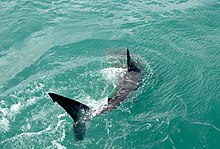
Stabilising fins are used as
Temperature regulation
Engineering fins are also used as heat transfer fins to regulate temperature in heat sinks or fin radiators.[26][27]
Ornamentation and other uses
In biology, fins can have an adaptive significance as sexual ornaments. During courtship, the female cichlid, Pelvicachromis taeniatus, displays a large and visually arresting purple pelvic fin. "The researchers found that males clearly preferred females with a larger pelvic fin and that pelvic fins grew in a more disproportionate way than other fins on female fish."[31][32]
Reshaping human feet with
The bodies of
The pectoral and pelvic fins of many reef fish, such as
Evolution

(1) pectoral fins (paired), (2) pelvic fins (paired), (3) dorsal fin, (4) adipose fin, (5) anal fin, and (6) caudal (tail) fin.
Aristotle recognised the distinction between
homologous structures, and made the following prophetic comparison: "Birds in a way resemble fishes. For birds have their wings in the upper part of their bodies and fishes have two fins in the front part of their bodies. Birds have feet on their underpart and most fishes have a second pair of fins in their under-part and near their front fins."
– Aristotle, De incessu animalium [44]
There is an old theory, proposed by anatomist Carl Gegenbaur, which has been often disregarded in science textbooks, "that fins and (later) limbs evolved from the gills of an extinct vertebrate". Gaps in the fossil record had not allowed a definitive conclusion. In 2009, researchers from the University of Chicago found evidence that the "genetic architecture of gills, fins and limbs is the same", and that "the skeleton of any appendage off the body of an animal is probably patterned by the developmental genetic program that we have traced back to formation of gills in sharks".[45][46][47] Recent studies support the idea that gill arches and paired fins are serially homologous and thus that fins may have evolved from gill tissues.[48]
Fish are the ancestors of all mammals, reptiles, birds and amphibians.[49] In particular, terrestrial tetrapods (four-legged animals) evolved from fish and made their first forays onto land 400 million years ago. They used paired pectoral and pelvic fins for locomotion. The pectoral fins developed into forelegs (arms in the case of humans) and the pelvic fins developed into hind legs.[50] Much of the genetic machinery that builds a walking limb in a tetrapod is already present in the swimming fin of a fish.[51][52]
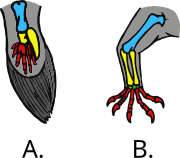
In 2011, researchers at Monash University in Australia used primitive but still living lungfish "to trace the evolution of pelvic fin muscles to find out how the load-bearing hind limbs of the tetrapods evolved."[53][54] Further research at the University of Chicago found bottom-walking lungfishes had already evolved characteristics of the walking gaits of terrestrial tetrapods.[55][56]
In a classic example of convergent evolution, the pectoral limbs of pterosaurs, birds and bats further evolved along independent paths into flying wings. Even with flying wings there are many similarities with walking legs, and core aspects of the genetic blueprint of the pectoral fin have been retained.[57][58]
About 200 million years ago the first mammals appeared. A group of these mammals started returning to the sea about 52 million years ago, thus completing a circle. These are the
"This sea-going reptile with terrestrial ancestors converged so strongly on fishes that it actually evolved a dorsal fin and tail in just the right place and with just the right hydrological design. These structures are all the more remarkable because they evolved from nothing — the ancestral terrestrial reptile had no hump on its back or blade on its tail to serve as a precursor."[65]
The biologist Stephen Jay Gould said the ichthyosaur was his favorite example of convergent evolution.[66]
Robotics
| External videos | |
|---|---|
The use of fins for
The AquaPenguin, developed by Festo of Germany, copies the streamlined shape and propulsion by front flippers of penguins.[72][73] Festo also developed AquaRay,[74] AquaJelly[75] and AiraCuda,[76] respectively emulating the locomotion of manta rays, jellyfish and barracuda.
In 2004,
Robotic fish offer some research advantages, such as the ability to examine part of a fish design in isolation from the rest, and variance of a single parameter, such as flexibility or direction. Researchers can directly measure forces more easily than in live fish. "Robotic devices also facilitate three-dimensional kinematic studies and correlated hydrodynamic analyses, as the location of the locomotor surface can be known accurately. And, individual components of a natural motion (such as outstroke vs. instroke of a flapping appendage) can be programmed separately, which is certainly difficult to achieve when working with a live animal."[79]
See also
- Aquatic locomotion
- Fin and flipper locomotion
- Fish locomotion
- Robot locomotion
- RoboTuna
- Sail (submarine)
- Surfboard fin
References
- ISBN 9780850451634.
- ^ Fin Oxford dictionary. Retrieved 24 November 2012.
- ^ Fin Archived 2020-11-26 at the Wayback Machine Merriam-Webster dictionary. Retrieved 24 November 2012.
- ^ S2CID 17226211. Archived from the original(PDF) on 2013-12-24.
- ISBN 9781444311907.
- ISBN 9780750681506.
- ISBN 9780750679695.
- ^ ISBN 9781402022326.
- ^ a b Brahic, Catherine (2008-03-28). "Dolphins swim so fast it hurts". New Scientist. Archived from the original on 2020-11-09. Retrieved 2008-03-31.
- from the original on 2020-08-07. Retrieved 2012-11-20.
- from the original on 2020-06-14. Retrieved 2021-05-19.
- (PDF) from the original on 2020-10-01. Retrieved 2012-11-20.
- from the original on 2016-03-04. Retrieved 2012-11-21.
- PMID 21708697.
- S2CID 4983205.
- ^ ISBN 9781852339593.
- ^ ISBN 9780691147192.
- ISBN 9780123504074.
- ^ Ship's movements at sea Archived November 25, 2011, at the Wayback Machine Retrieved 22 November 2012.
- ISBN 9780074603154.
- S2CID 827610.
- ISBN 9780595432073.
- ISBN 9781434421258.
- ISBN 9781904381228.
- ^ Khalid M, Sun Y and Xu H (1998) "Computation of Flows Past Grid Fin Missiles"[permanent dead link] AVT Symposium on Missile Aerodynamics, Sorrento, Italy.
- ISBN 9781560328391.
- ^ Fin: Function in aircraft engines Archived 2023-12-16 at the Wayback Machine Encyclopædia Britannica. Retrieved 22 November 2012.
- ^ Clarke, Massimo (2010)
Modern Motorcycle Technology Archived 2023-12-16 at the ISBN 9780760338193.
- ISBN 9780761471707.
- ^ Dement J Species Spotlight: Atlantic Sailfish (Istiophorus albicans) Archived December 17, 2010, at the Wayback Machine littoralsociety.org. Retrieved 1 April 2012.
- ^ Female fish flaunt fins to attract a mate Archived 2019-05-20 at the Wayback Machine ScienceDaily. 8 October 2010.
- PMID 20932273.
- ^ Stromer, E. (1915). "Ergebnisse der Forschungsreisen Prof. E. Stromers in den Wüsten Ägyptens. II. Wirbeltier-Reste der Baharije-Stufe (unterstes Cenoman). 3. Das Original des Theropoden Spinosaurus aegyptiacus nov. gen., nov. spec". Abhandlungen der Königlich Bayerischen Akademie der Wissenschaften, Mathematisch-physikalische Klasse (in German). 28 (3): 1–32.[permanent dead link]
- ISBN 9780760309612.
- S2CID 34505861.
- PMID 7580765. Archived from the original on 2011-08-11. Retrieved 2008-08-25.)
{{cite journal}}: CS1 maint: unfit URL (link - ^ Brandner PA and Walker GJ (2004) Hydrodynamic Performance of a Surfboard Fin Archived 2020-10-30 at the Wayback Machine 15th Australasian Fluid Mechanics Conference, Sydney.
- ^ ISBN 978-1-55992-077-3. Archivedfrom the original on 2023-12-16. Retrieved 2018-04-24.
- ^ a b Ichthyology Archived 2016-01-05 at the Wayback Machine Florida Museum of Natural History. Retrieved 22 November 2012.
- ^ Vannuccini S (1999). "Shark utilization, marketing and trade". FAO Fisheries Technical Paper. 389. Archived from the original on 2017-08-02. Retrieved 2012-11-26.
- ^ Ridhwan CZ (2008) Aerodynamics of aftermarket rear spoiler Archived 2011-11-11 at the Wayback Machine University Malaysia Pahang
- ISBN 978-0-12-547665-2.
- doi:10.1111/j.1469-7998.1990.tb04009.x. Archived from the original(PDF) on 2013-10-20.
- doi:10.1093/icb/28.2.449. Archived from the original(PDF) on 2015-09-24. Retrieved 2014-11-08.
- ^ Evolution Of Fins And Limbs Linked With That Of Gills Archived 2019-05-30 at the Wayback Machine ScienceDaily. 25 March 2009.
- PMID 19321424.
- ^ Wings, legs, and fins: How do new organs arise in evolution? Archived 2020-09-27 at the Wayback Machine Neil Shubin, University of Chicago.
- PMID 33198887.
- ^ "Primordial Fish Had Rudimentary Fingers" Archived 2020-09-27 at the Wayback Machine ScienceDaily, 23 September 2008.
- ISBN 9780226313375.
- ISBN 9780253356758.
- ^ Lungfish Provides Insight to Life On Land: 'Humans Are Just Modified Fish' Archived 2020-11-11 at the Wayback Machine ScienceDaily, 7 October 2011.
- PMID 21990962.
- ^ A small step for lungfish, a big step for the evolution of walking" Archived 2017-07-03 at the Wayback Machine ScienceDaily, 13 December 2011.
- PMID 22160688.
- S2CID 2913898. Archived from the original(PDF) on 2012-09-16.
- ^ Vertebrate flight: The three solutions Archived 2012-11-10 at the Wayback Machine University of California. Updated 29 September 2005.
- ^ "Scientists find missing link between the dolphin, whale and its closest relative, the hippo". Science News Daily. 2005-01-25. Archived from the original on 2007-03-04. Retrieved 2007-06-18.
- PMID 9159931.
- PMID 16012099.
- ^ Felts WJL "Some functional and structural characteristics of cetacean flippers and flukes" Archived 2023-12-16 at the Wayback Machine Pages 255–275 in: Norris KS (ed.) Whales, Dolphins, and Porpoises, University of California Press.
- ^ The evolution of whales Archived 2020-12-16 at the Wayback Machine University of California Museum. Retrieved 27 November 2012.
- (PDF) from the original on 2020-07-31. Retrieved 2012-11-26.
- ^ Martill D.M. (1993). "Soupy Substrates: A Medium for the Exceptional Preservation of Ichthyosaurs of the Posidonia Shale (Lower Jurassic) of Germany". Kaupia – Darmstädter Beiträge zur Naturgeschichte, 2 : 77–97.
- ISBN 9780393311396.
- ^ Richard Mason. "What is the market for robot fish?". Archived from the original on 2009-07-04.
- ^ Witoon Juwarahawong. "Fish Robot". Institute of Field Robotics. Archived from the original on 2007-11-04. Retrieved 2007-10-25.
- ^ "Robotic fish powered by Gumstix PC and PIC". Human Centred Robotics Group at Essex University. Archived from the original on 2011-08-14. Retrieved 2007-10-25.
- ^ "Robotic fish make aquarium debut". cnn.com. CNN. 10 October 2005. Archived from the original on 26 November 2020. Retrieved 12 June 2011.
- ^ Walsh, Dominic (3 May 2008). "Merlin Entertainments tops up list of London attractions with aquarium buy". thetimes.co.uk. Times of London. Archived from the original on 21 December 2016. Retrieved 12 June 2011.
- ^ For Festo, Nature Shows the Way Archived 2020-09-28 at the Wayback Machine Control Engineering, 18 May 2009.
- ^ Bionic penguins fly through water... and air Archived 2016-03-04 at the Wayback Machine Gizmag, 27 April 2009.
- ^ Festo AquaRay Robot Archived 2020-11-24 at the Wayback Machine Technovelgy, 20 April 2009.
- ^ The AquaJelly Robotic Jellyfish from Festo Archived 2015-09-24 at the Wayback Machine Engineering TV, 12 July 2012.
- ^ Lightweight robots: Festo's flying circus Archived 2015-09-19 at the Wayback Machine The Engineer, 18 July 2011.
- PMID 15679914.
- ^ How Biomechatronics Works Archived 2020-12-05 at the Wayback Machine HowStuffWorks/ Retrieved 22 November 2012.
- (PDF) from the original on 2019-12-06. Retrieved 2012-11-20.
Further reading
- Blake, Robert William (2004). "Fish functional design and swimming performance". Journal of Fish Biology. 65 (5): 1193–1222. .
- Blake, Robert William (1983) Fish Locomotion Archived 2023-12-16 at the ISBN 9780521243032.
- Breder, CM (1926). "The locomotion of fishes". Zoologica. 4: 159–297.
- Fish, FE; Peacock, JE; Rohr, JJ (2002). "Stabilization Mechanism in Swimming Odontocete Cetaceans by Phased Movements" (PDF). Marine Mammal Science. 19 (3): 515–528. (PDF) from the original on 2017-02-28. Retrieved 2012-11-23.
- Hawkins, JD; Sepulveda, CA; Graham, JB; Dickson, KA (2003). "Swimming performance studies on the eastern Pacific bonito Sarda chiliensis, a close relative of the tunas (family Scombridae) II. Kinematics". The Journal of Experimental Biology. 206 (16): 2749–2758. PMID 12847120.
- Lauder, GV; Drucker, EG (2004). "Morphology and experimental hydrodynamics of fish fin control surfaces" (PDF). Journal of Oceanic Engineering. 29 (3): 556–571. (PDF) from the original on 2020-10-03. Retrieved 2012-12-03.
- Lauder, GV; Madden, PGA (2007). "Fish locomotion: kinematics and hydrodynamics of flexible foil-like fins" (PDF). Experiments in Fluids. 43 (5): 641–653. S2CID 4998727. Archived from the original(PDF) on 2012-12-24.
- Standen, EM (2009). "Muscle activity and hydrodynamic function of pelvic fins in trout (Oncorhynchus mykiss)". The Journal of Experimental Biology. 213 (5): 831–841. PMID 20154199.
- Tangorra JL, CEsposito CJ and Lauder GV (2009) "Biorobotic fins for investigations of fish locomotion" Archived 2011-04-01 at the ISBN 978-1-4244-3804-4.
- Tu X and Terzopoulos D (1994) "Artificial fishes: Physics, locomotion, perception, behavior"[
- Weihs, Daniel (2002). "Stability versus maneuverability in aquatic locomotion". Integrated and Computational Biology. 42 (1): 127–134. PMID 21708701.
External links
| External videos | |
|---|---|
- Locomotion in Fish Earthlife.
- Computational fluid dynamics tutorial Many examples and images, with references to robotic fish.
- Fish Skin Research University of British Columbia.
- A fin-tuned design The Economist, 19 November 2008.




